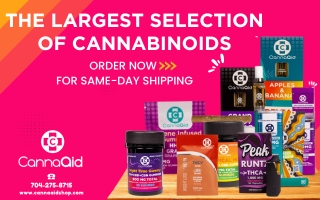
“We are, without question . . . the leader in our industry, whether in knowledge, science, manufacturing or distribution—and we always will be.”
Did you hear that? That’s the sound of the gauntlet hitting hard-packed earth. Bang.
That was MT Brands™ CEO and founder, James Morrissette, channeling his inner-Kanye to let the industry know exactly where his company stands, unapologetically and unflinchingly.
To Morrissette, his company’s place within the kratom niche is a foregone conclusion. He’s not making an argument. As far as he’s concerned, he’s stating a fact—and you can take it or leave it. Though, he’s fairly confident you’ll take it, since you’re an informed business owner who makes smart purchasing decisions.
If MT Brands™ doesn’t initially get the memory bells chiming, that’s OK. You’re probably more familiar with Bio Botanical™, their premium kratom line, currently offered in eight varietals. You’re likely also familiar with their more price-competitive brand, The Devils™ Kratom, also marketed to the quickly growing Latino sector as El Diablos™ Kratom. Though there is a significant price differential between the two brands, the market viability of both hinges on the notion of quality in both purity and strength, backed by an extensive selection of point of sale material for their retailers.
“We’re widely recognized not only for the quality of our bottles, but also how they look on the shelf,” Morrissette asserts, “as well as our excellent counter displays, posters and promotional items. Those things are a huge help to our customers who carry Bio Botanical™ and Devils™ Kratom.”
But those are just the brands they want you to know. The fact is, if the kratom you carry is of certifiable quality, there’s a high probability that it’s one of their white labels.
In saying that, however, there’s an important distinction to be made. Notice, I didn’t just say “quality.” The operative word here is “certifiable,” meaning that there is a system in place to verify the product at multiple points along the supply chain. This is essential.
“We’ve delved deeply into understanding cGMP standards and the federal regulations for manufacturing, which is absolutely critical,” Morrissette explains. “Because of these efforts, we’re now viewed by many as the authority on the processes and procedures associated with cGMP for the kratom industry.”
CGMP. You’ve likely heard that term before. It stands for “current good manufacturing practices” and is defined as the practices required to conform to the FDA guidelines in the production of a food, drug, dietary supplement or medical device. What a lot of people don’t understand is that cGMP is more than just adherence to a set of rules. It’s a bit more fluid than that. The authorities put out their guidelines that govern each industry, yes, but then they expect those industries to develop their own standards and protocols by which they adhere to
those guidelines. It’s a continually evolving process, especially in a nascent industry such as kratom, where no standards have really been set. Yes, there are the generic dietary supplement standards to follow—and that’s a great starting point, but how many other dietary supplements are sourced from the jungles of third world countries? This is why Morrissette and his team are striving for a big picture solution, what he calls a “seed to table” system.
“I’ve spent a lot of time in Indonesia,” he qualifies. “I’ve seen their process. They’re drying these leaves on the ground, they don’t wear shirts, they don’t wear shoes, they’re wearing shorts, there are animals running around, there’s nothing sanitary about this at all . . . I mean, this is just not the correct thing to do in order to have a cGMP process . . . I can’t disclose much at this point, but we are in the process of eliminating all of those liabilities. For now, we’re starting with a COA—testing the product for safety when it hits the United States’ shores, but that’s only our minimum. And honestly, I don’t think many companies are even doing that correctly.”

As Morrissette points out, a lot of their competitors can’t even get the label right, which is practically 101-level cGMP. “Look at the label,” he insists. “If it doesn’t look like ours, it’s not cGMP.”
But in going straight from the source country to the label specs, we’ve skipped an important step, and that is the how and where of the manufacturing process.
“We have a 60,000 square foot manufacturing facility and we’re building out another 30,000 square foot building close by,” he offers. “And it’s all built to an ISO Class 8 Cleanroom standard. That’s a very specific classification.” Specific, indeed, as well as impressive. Put simply, an ISO Class 8 Cleanroom has an air quality 100,000x cleaner than outside air. They are not cutting corners—on anything.
The company’s meticulous efforts extend far beyond the quality of their manufacturing. They’re doubling as activists, supporting and working actively with the American Kratom Association to ensure the precious leaf is here to stay for all of us. For Morrissette, it’s about more than just MT Brands™. He recognizes his reliance on the ecosystem in which he’s chosen to exist and accordingly, has sought to develop a path forward by which all the legitimate players can grow and thrive. It’s the “rising tide lifts all boats” strategy, more or less.
Perhaps their biggest victory to date is the passage of the Kratom Consumer Protection Act in four states—Georgia, Nevada, Arizona and Utah. The act basically codifies a stringent set of standards required for the manufacturing of any kratom product sold within the borders of those states where it has become law. The benefits for the industry are twofold. First, as Morrissette explains, it “weeds out the bad actors.” Second, by virtue of the law’s existence, it provides a default legality for kratom within those states, eliminating the gray area in which the market currently exists, at least on a state level.
Believe it or not,” Morrissette adds, “we have 21 additional states where the bill is being
presented and we’re very confident that they’ll go through. That means, if we’re successful, we’ll have a Kratom Consumer Protection Act in 25 states.”
At the Federal level, there have been no tangible movements yet, but he’s making regular trips to the nation’s capital to plant the seeds there as well, and he’s confident in what he’s beginning to see.
“I have some incredible consultants in D.C.,” he says. “I think we’ll to begin to see a lot more support in Congress, in both the Senate and the House . . . I don’t think there’s really any chance at all that kratom could be made illegal in the United States. As a matter of fact, I see it on an upward climb.”












